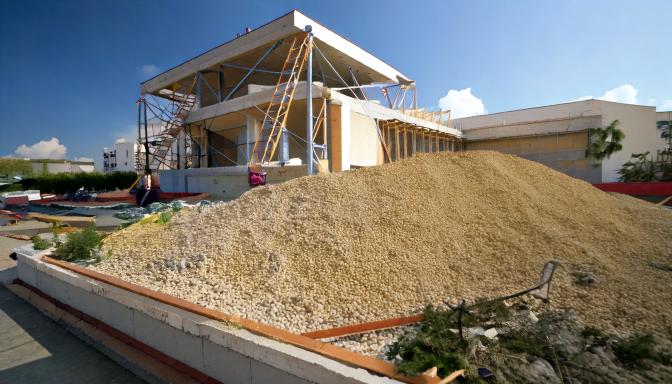Blocks
Building blocks, available in various sizes, can be produced using cement and perlite in different gradations (a combination of 1-3 mm and 3-5 mm gradations is more effective) by adding a plasticizer or a composite mix of cement, perlite, vermiculite, and other sands and aggregates.
It is clear that the more materials are used in these composites, the less the properties of perlite are preserved.
Therefore, if the goal is to utilize the properties of perlite such as lightweight, sound insulation, or thermal insulation, it is better to make the blocks using only perlite and cement.
Perlite blocks are produced in both pressed and poured forms, and can be either solid or hollow.
Solid and pressed blocks have the best and most significant perlite properties.
Facade and Flooring Stones
Perlite can also be used in artificial stones produced for both interior and exterior facades of buildings.
If this artificial stone is used for the rooftop flooring over an insulation layer, it will protect the top floor of the building from both heat and cold.
Perlite Insulating and Fireproof Composite
By using this composite in the construction industry, humanity will experience the benefits of fireproof and insulated buildings for the first time. The following outcomes will occur:
1) Sound will not transfer from one room to another or from one floor to another.
2) Sound will not transfer through doors.
3) If a fire occurs in one room, the temperature and fire will not spread to another room.
4) To heat or cool a room, there will be no need for continuous operation of the heating and cooling system. Once the temperature reaches, for example, 20°C, it will remain at that level for a long time without needing to operate the heating or cooling source.
5) Buildings will be much lighter, significantly affecting structural calculations, and improving the building’s resistance to earthquakes.
6) Water will not be consumed during the construction of walls.
7) The construction of walls, which will be 3 meters high and 30 to 50 centimeters wide with thicknesses of 7, 10, and 15 centimeters, will be done very quickly, and electrical and mechanical installations will be carved into them using machines.
Use of Perlite Powder in Construction
- Plastering
- Cementing
- Lightweight Concrete
Perlite Use in Construction:
- It is possible to fill the holes and cavities of hollow blocks or clay bricks with perlite in various particle sizes, preferably from 0 to 1 mm.
- For sloping the roofs of buildings, perlite can be used as a substitute for pumice.
Perlite in Cement Work:
Perlite can be used instead of sand in cement work. In this case, depending on the thickness of the cement layer, the soundproofing and thermal insulation properties of perlite can be utilized.
Using Perlite in Concrete:
By using perlite, cement, and in some cases adding lightweight fillers, lightweight concrete can be produced for non-structural elements of buildings.



